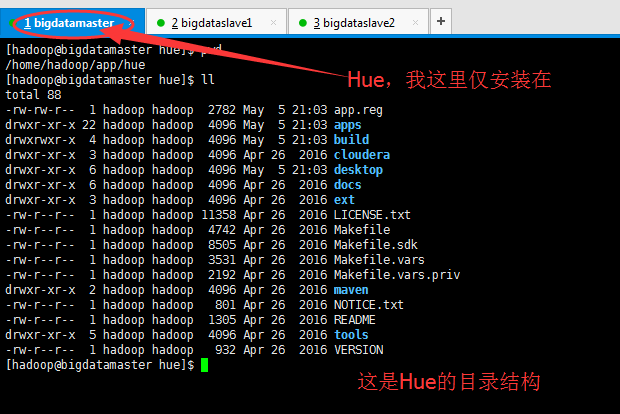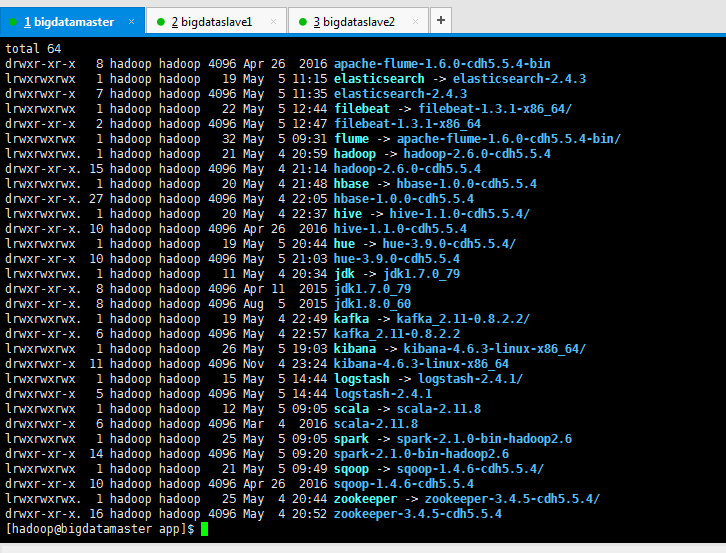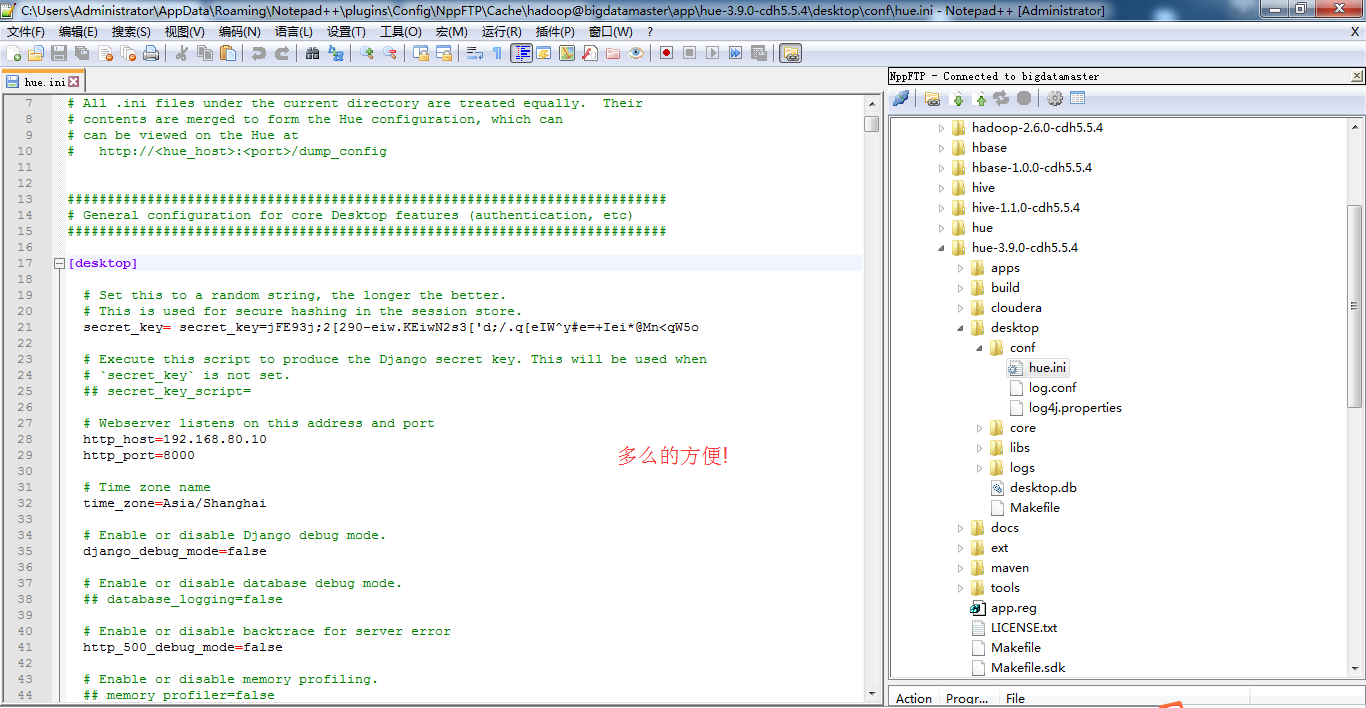不多说,直接上干货!
我的集群机器情况是 bigdatamaster(192.168.80.10)、bigdataslave1(192.168.80.11)和bigdataslave2(192.168.80.12)
然后,安装目录是在/home/hadoop/app下。
官方建议在master机器上安装Hue,我这里也不例外。安装在bigdatamaster机器上。
Hue版本:hue-3.9.0-cdh5.5.4
需要编译才能使用(联网)
说给大家的话:大家电脑的配置好的话,一定要安装cloudera manager。毕竟是一家人的。
同时,我也亲身经历过,会有部分组件版本出现问题安装起来要个大半天时间去排除,做好心里准备。废话不多说,因为我目前读研,自己笔记本电脑最大8G,只能玩手动来练手。
纯粹是为了给身边没高配且条件有限的学生党看的! 但我已经在实验室机器群里搭建好cloudera manager 以及 ambari都有。
大数据领域两大最主流集群管理工具Ambari和Cloudera Manger
Cloudera安装搭建部署大数据集群(图文分五大步详解)(博主强烈推荐)
Ambari安装搭建部署大数据集群(图文分五大步详解)(博主强烈推荐)
前期博客
CDH版本大数据集群下搭建Hue(hadoop-2.6.0-cdh5.5.4.gz + hue-3.9.0-cdh5.5.4.tar.gz)(博主推荐)

[hadoop@bigdatamaster hue]$ pwd /home/hadoop/app/hue [hadoop@bigdatamaster hue]$ ll total 88 -rw-rw-r-- 1 hadoop hadoop 2782 May 5 21:03 app.reg drwxr-xr-x 22 hadoop hadoop 4096 May 5 21:03 apps drwxrwxr-x 4 hadoop hadoop 4096 May 5 21:03 build drwxr-xr-x 3 hadoop hadoop 4096 Apr 26 2016 cloudera drwxr-xr-x 6 hadoop hadoop 4096 May 5 21:03 desktop drwxr-xr-x 6 hadoop hadoop 4096 Apr 26 2016 docs drwxr-xr-x 3 hadoop hadoop 4096 Apr 26 2016 ext -rw-r--r-- 1 hadoop hadoop 11358 Apr 26 2016 LICENSE.txt -rw-r--r-- 1 hadoop hadoop 4742 Apr 26 2016 Makefile -rw-r--r-- 1 hadoop hadoop 8505 Apr 26 2016 Makefile.sdk -rw-r--r-- 1 hadoop hadoop 3531 Apr 26 2016 Makefile.vars -rw-r--r-- 1 hadoop hadoop 2192 Apr 26 2016 Makefile.vars.priv drwxr-xr-x 2 hadoop hadoop 4096 Apr 26 2016 maven -rw-r--r-- 1 hadoop hadoop 801 Apr 26 2016 NOTICE.txt -rw-r--r-- 1 hadoop hadoop 1305 Apr 26 2016 README drwxr-xr-x 5 hadoop hadoop 4096 Apr 26 2016 tools -rw-r--r-- 1 hadoop hadoop 932 Apr 26 2016 VERSION [hadoop@bigdatamaster hue]$
首先,大家一应要看清我的3个节点的集群机器情况!(不看清楚,自己去后悔吧)



进入 $HUE_HOME/desktop/conf/hue.ini

关于这里,给大家一个很好的技巧
大数据搭建各个子项目时配置文件技巧(适合CentOS和Ubuntu系统)(博主推荐)

以下是我的配置文件(注意不是默认的)(作为大家参考) (这个配置文件,是根据大家的机器变动而走的)(动态的)
# Hue configuration file # =================================== # # For complete documentation about the contents of this file, run # $ <hue_root>/build/env/bin/hue config_help # # All .ini files under the current directory are treated equally. Their # contents are merged to form the Hue configuration, which can # can be viewed on the Hue at # http://<hue_host>:<port>/dump_config
########################################################################### # General configuration for core Desktop features (authentication, etc) ###########################################################################
[desktop]
# Set this to a random string, the longer the better.
# This is used for secure hashing in the session store.
secret_key= secret_key=jFE93j;2[290-eiw.KEiwN2s3['d;/.q[eIW^y#e=+Iei*@Mn<qW5o
# Execute this script to produce the Django secret key. This will be used when
# `secret_key` is not set.
## secret_key_script=
# Webserver listens on this address and port
http_host=192.168.80.10
http_port=8000
# Time zone name
time_zone=Asia/Shanghai
# Enable or disable Django debug mode.
django_debug_mode=false
# Enable or disable database debug mode.
## database_logging=false
# Enable or disable backtrace for server error
http_500_debug_mode=false
# Enable or disable memory profiling.
## memory_profiler=false
# Server email for internal error messages
## django_server_email='hue@localhost.localdomain'
# Email backend
## django_email_backend=django.core.mail.backends.smtp.EmailBackend
# Webserver runs as this user
server_user=hue
server_group=hue
# This should be the Hue admin and proxy user
default_user=hue
# This should be the hadoop cluster admin
efault_hdfs_superuser=hadoop
# If set to false, runcpserver will not actually start the web server.
# Used if Apache is being used as a WSGI container.
## enable_server=yes
# Number of threads used by the CherryPy web server
## cherrypy_server_threads=40
# Filename of SSL Certificate
## ssl_certificate=
# Filename of SSL RSA Private Key
## ssl_private_key=
# Filename of SSL Certificate Chain
## ssl_certificate_chain=
# SSL certificate password
## ssl_password=
# Execute this script to produce the SSL password. This will be used when `ssl_password` is not set.
## ssl_password_script=
# List of allowed and disallowed ciphers in cipher list format.
# See http://www.openssl.org/docs/apps/ciphers.html for more information on
# cipher list format. This list is from
# https://wiki.mozilla.org/Security/Server_Side_TLS v3.7 intermediate
# recommendation, which should be compatible with Firefox 1, Chrome 1, IE 7,
# Opera 5 and Safari 1.
## ssl_cipher_list=ECDHE-RSA-AES128-GCM-SHA256:ECDHE-ECDSA-AES128-GCM-SHA256:ECDHE-RSA-AES256-GCM-SHA384:ECDHE-ECDSA-AES256-GCM-SHA384:DHE-RSA-AES128-GCM-SHA256:DHE-DSS-AES128-GCM-SHA256:kEDH+AESGCM:ECDHE-RSA-AES128-SHA256:ECDHE-ECDSA-AES128-SHA256:ECDHE-RSA-AES128-SHA:ECDHE-ECDSA-AES128-SHA:ECDHE-RSA-AES256-SHA384:ECDHE-ECDSA-AES256-SHA384:ECDHE-RSA-AES256-SHA:ECDHE-ECDSA-AES256-SHA:DHE-RSA-AES128-SHA256:DHE-RSA-AES128-SHA:DHE-DSS-AES128-SHA256:DHE-RSA-AES256-SHA256:DHE-DSS-AES256-SHA:DHE-RSA-AES256-SHA:AES128-GCM-SHA256:AES256-GCM-SHA384:AES128-SHA256:AES256-SHA256:AES128-SHA:AES256-SHA:AES:CAMELLIA:DES-CBC3-SHA:!aNULL:!eNULL:!EXPORT:!DES:!RC4:!MD5:!PSK:!aECDH:!EDH-DSS-DES-CBC3-SHA:!EDH-RSA-DES-CBC3-SHA:!KRB5-DES-CBC3-SHA
# Path to default Certificate Authority certificates.
## ssl_cacerts=/etc/hue/cacerts.pem
# Choose whether Hue should validate certificates received from the server.
## validate=true
# Default LDAP/PAM/.. username and password of the hue user used for authentications with other services.
# e.g. LDAP pass-through authentication for HiveServer2 or Impala. Apps can override them individually.
## auth_username=hue
## auth_password=
# Default encoding for site data
## default_site_encoding=utf-8
# Help improve Hue with anonymous usage analytics.
# Use Google Analytics to see how many times an application or specific section of an application is used, nothing more.
## collect_usage=true
# Enable X-Forwarded-Host header if the load balancer requires it.
## use_x_forwarded_host=false
# Support for HTTPS termination at the load-balancer level with SECURE_PROXY_SSL_HEADER.
## secure_proxy_ssl_header=false
# Comma-separated list of Django middleware classes to use.
# See https://docs.djangoproject.com/en/1.4/ref/middleware/ for more details on middlewares in Django.
## middleware=desktop.auth.backend.LdapSynchronizationBackend
# Comma-separated list of regular expressions, which match the redirect URL.
# For example, to restrict to your local domain and FQDN, the following value can be used:
# ^/.*$,^http://www.mydomain.com/.*$
## redirect_whitelist=^/.*$
# Comma separated list of apps to not load at server startup.
# e.g.: pig,zookeeper
## app_blacklist=
# The directory where to store the auditing logs. Auditing is disable if the value is empty.
# e.g. /var/log/hue/audit.log
## audit_event_log_dir=
# Size in KB/MB/GB for audit log to rollover.
## audit_log_max_file_size=100MB
# A json file containing a list of log redaction rules for cleaning sensitive data
# from log files. It is defined as:
#
# {
# "version": 1,
# "rules": [
# {
# "description": "This is the first rule",
# "trigger": "triggerstring 1",
# "search": "regex 1",
# "replace": "replace 1"
# },
# {
# "description": "This is the second rule",
# "trigger": "triggerstring 2",
# "search": "regex 2",
# "replace": "replace 2"
# }
# ]
# }
#
# Redaction works by searching a string for the [TRIGGER] string. If found,
# the [REGEX] is used to replace sensitive information with the
# [REDACTION_MASK]. If specified with `log_redaction_string`, the
# `log_redaction_string` rules will be executed after the
# `log_redaction_file` rules.
#
# For example, here is a file that would redact passwords and social security numbers:
# {
# "version": 1,
# "rules": [
# {
# "description": "Redact passwords",
# "trigger": "password",
# "search": "password=".*"",
# "replace": "password="???""
# },
# {
# "description": "Redact social security numbers",
# "trigger": "",
# "search": "d{3}-d{2}-d{4}",
# "replace": "XXX-XX-XXXX"
# }
# ]
# }
## log_redaction_file=
# Comma separated list of strings representing the host/domain names that the Hue server can serve.
# e.g.: localhost,domain1,*
## allowed_hosts=*
# Administrators
# ----------------
[[django_admins]]
## [[[admin1]]]
## name=john
## email=john@doe.com
# UI customizations
# -------------------
[[custom]]
# Top banner HTML code
# e.g. <H2>Test Lab A2 Hue Services</H2>
## banner_top_html=
# Configuration options for user authentication into the web application
# ------------------------------------------------------------------------
[[auth]]
# Authentication backend. Common settings are:
# - django.contrib.auth.backends.ModelBackend (entirely Django backend)
# - desktop.auth.backend.AllowAllBackend (allows everyone)
# - desktop.auth.backend.AllowFirstUserDjangoBackend
# (Default. Relies on Django and user manager, after the first login)
# - desktop.auth.backend.LdapBackend
# - desktop.auth.backend.PamBackend
# - desktop.auth.backend.SpnegoDjangoBackend
# - desktop.auth.backend.RemoteUserDjangoBackend
# - libsaml.backend.SAML2Backend
# - libopenid.backend.OpenIDBackend
# - liboauth.backend.OAuthBackend
# (New oauth, support Twitter, Facebook, Google+ and Linkedin
## backend=desktop.auth.backend.AllowFirstUserDjangoBackend
# The service to use when querying PAM.
## pam_service=login
# When using the desktop.auth.backend.RemoteUserDjangoBackend, this sets
# the normalized name of the header that contains the remote user.
# The HTTP header in the request is converted to a key by converting
# all characters to uppercase, replacing any hyphens with underscores
# and adding an HTTP_ prefix to the name. So, for example, if the header
# is called Remote-User that would be configured as HTTP_REMOTE_USER
#
# Defaults to HTTP_REMOTE_USER
## remote_user_header=HTTP_REMOTE_USER
# Ignore the case of usernames when searching for existing users.
# Only supported in remoteUserDjangoBackend.
## ignore_username_case=true
# Ignore the case of usernames when searching for existing users to authenticate with.
# Only supported in remoteUserDjangoBackend.
## force_username_lowercase=true
# Users will expire after they have not logged in for 'n' amount of seconds.
# A negative number means that users will never expire.
## expires_after=-1
# Apply 'expires_after' to superusers.
## expire_superusers=true
# Force users to change password on first login with desktop.auth.backend.AllowFirstUserDjangoBackend
## change_default_password=false
# Number of login attempts allowed before a record is created for failed logins
## login_failure_limit=3
# After number of allowed login attempts are exceeded, do we lock out this IP and optionally user agent?
## login_lock_out_at_failure=false
# If set, defines period of inactivity in seconds after which failed logins will be forgotten
## login_cooloff_time=60
# If True, lock out based on IP and browser user agent
## login_lock_out_by_combination_browser_user_agent_and_ip=false
# If True, lock out based on IP and user
## login_lock_out_by_combination_user_and_ip=false
# Configuration options for connecting to LDAP and Active Directory
# -------------------------------------------------------------------
[[ldap]]
# The search base for finding users and groups
## base_dn="DC=mycompany,DC=com"
# URL of the LDAP server
## ldap_url=ldap://auth.mycompany.com
# A PEM-format file containing certificates for the CA's that
# Hue will trust for authentication over TLS.
# The certificate for the CA that signed the
# LDAP server certificate must be included among these certificates.
# See more here http://www.openldap.org/doc/admin24/tls.html.
## ldap_cert=
## use_start_tls=true
# Distinguished name of the user to bind as -- not necessary if the LDAP server
# supports anonymous searches
## bind_dn="CN=ServiceAccount,DC=mycompany,DC=com"
# Password of the bind user -- not necessary if the LDAP server supports
# anonymous searches
## bind_password=
# Execute this script to produce the bind user password. This will be used
# when `bind_password` is not set.
## bind_password_script=
# Pattern for searching for usernames -- Use <username> for the parameter
# For use when using LdapBackend for Hue authentication
## ldap_username_pattern="uid=<username>,ou=People,dc=mycompany,dc=com"
# Create users in Hue when they try to login with their LDAP credentials
# For use when using LdapBackend for Hue authentication
## create_users_on_login = true
# Synchronize a users groups when they login
## sync_groups_on_login=false
# Ignore the case of usernames when searching for existing users in Hue.
## ignore_username_case=true
# Force usernames to lowercase when creating new users from LDAP.
## force_username_lowercase=true
# Use search bind authentication.
## search_bind_authentication=true
# Choose which kind of subgrouping to use: nested or suboordinate (deprecated).
## subgroups=suboordinate
# Define the number of levels to search for nested members.
## nested_members_search_depth=10
# Whether or not to follow referrals
## follow_referrals=false
# Enable python-ldap debugging.
## debug=false
# Sets the debug level within the underlying LDAP C lib.
## debug_level=255
# Possible values for trace_level are 0 for no logging, 1 for only logging the method calls with arguments,
# 2 for logging the method calls with arguments and the complete results and 9 for also logging the traceback of method calls.
## trace_level=0
[[[users]]]
# Base filter for searching for users
## user_filter="objectclass=*"
# The username attribute in the LDAP schema
## user_name_attr=sAMAccountName
[[[groups]]]
# Base filter for searching for groups
## group_filter="objectclass=*"
# The group name attribute in the LDAP schema
## group_name_attr=cn
# The attribute of the group object which identifies the members of the group
## group_member_attr=members
[[[ldap_servers]]]
## [[[[mycompany]]]]
# The search base for finding users and groups
## base_dn="DC=mycompany,DC=com"
# URL of the LDAP server
## ldap_url=ldap://auth.mycompany.com
# A PEM-format file containing certificates for the CA's that
# Hue will trust for authentication over TLS.
# The certificate for the CA that signed the
# LDAP server certificate must be included among these certificates.
# See more here http://www.openldap.org/doc/admin24/tls.html.
## ldap_cert=
## use_start_tls=true
# Distinguished name of the user to bind as -- not necessary if the LDAP server
# supports anonymous searches
## bind_dn="CN=ServiceAccount,DC=mycompany,DC=com"
# Password of the bind user -- not necessary if the LDAP server supports
# anonymous searches
## bind_password=
# Execute this script to produce the bind user password. This will be used
# when `bind_password` is not set.
## bind_password_script=
# Pattern for searching for usernames -- Use <username> for the parameter
# For use when using LdapBackend for Hue authentication
## ldap_username_pattern="uid=<username>,ou=People,dc=mycompany,dc=com"
## Use search bind authentication.
## search_bind_authentication=true
# Whether or not to follow referrals
## follow_referrals=false
# Enable python-ldap debugging.
## debug=false
# Sets the debug level within the underlying LDAP C lib.
## debug_level=255
# Possible values for trace_level are 0 for no logging, 1 for only logging the method calls with arguments,
# 2 for logging the method calls with arguments and the complete results and 9 for also logging the traceback of method calls.
## trace_level=0
## [[[[[users]]]]]
# Base filter for searching for users
## user_filter="objectclass=Person"
# The username attribute in the LDAP schema
## user_name_attr=sAMAccountName
## [[[[[groups]]]]]
# Base filter for searching for groups
## group_filter="objectclass=groupOfNames"
# The username attribute in the LDAP schema
## group_name_attr=cn
# Configuration options for specifying the Desktop Database. For more info,
# see http://docs.djangoproject.com/en/1.4/ref/settings/#database-engine
# ------------------------------------------------------------------------
[[database]]
# Database engine is typically one of:
# postgresql_psycopg2, mysql, sqlite3 or oracle.
#
# Note that for sqlite3, 'name', below is a path to the filename. For other backends, it is the database name.
# Note for Oracle, options={"threaded":true} must be set in order to avoid crashes.
# Note for Oracle, you can use the Oracle Service Name by setting "port=0" and then "name=<host>:<port>/<service_name>".
# Note for MariaDB use the 'mysql' engine.
## engine=sqlite3
## host=
## port=
## user=
## password=
## name=desktop/desktop.db
## options={}
# Configuration options for specifying the Desktop session.
# For more info, see https://docs.djangoproject.com/en/1.4/topics/http/sessions/
# ------------------------------------------------------------------------
[[session]]
# The cookie containing the users' session ID will expire after this amount of time in seconds.
# Default is 2 weeks.
## ttl=1209600
# The cookie containing the users' session ID will be secure.
# Should only be enabled with HTTPS.
## secure=false
# The cookie containing the users' session ID will use the HTTP only flag.
## http_only=true
# Use session-length cookies. Logs out the user when she closes the browser window.
## expire_at_browser_close=false
# Configuration options for connecting to an external SMTP server
# ------------------------------------------------------------------------
[[smtp]]
# The SMTP server information for email notification delivery
host=localhost
port=25
user=
password=
# Whether to use a TLS (secure) connection when talking to the SMTP server
tls=no
# Default email address to use for various automated notification from Hue
## default_from_email=hue@localhost
# Configuration options for Kerberos integration for secured Hadoop clusters
# ------------------------------------------------------------------------
[[kerberos]]
# Path to Hue's Kerberos keytab file
## hue_keytab=
# Kerberos principal name for Hue
## hue_principal=hue/hostname.foo.com
# Path to kinit
## kinit_path=/path/to/kinit
# Configuration options for using OAuthBackend (Core) login
# ------------------------------------------------------------------------
[[oauth]]
# The Consumer key of the application
## consumer_key=XXXXXXXXXXXXXXXXXXXXX
# The Consumer secret of the application
## consumer_secret=XXXXXXXXXXXXXXXXXXXXXXXXXXXXXXXXXXXXXXXX
# The Request token URL
## request_token_url=https://api.twitter.com/oauth/request_token
# The Access token URL
## access_token_url=https://api.twitter.com/oauth/access_token
# The Authorize URL
## authenticate_url=https://api.twitter.com/oauth/authorize
# Configuration options for Metrics
# ------------------------------------------------------------------------
[[metrics]]
# Enable the metrics URL "/desktop/metrics"
## enable_web_metrics=True
# If specified, Hue will write metrics to this file.
## location=/var/log/hue/metrics.json
# Time in milliseconds on how frequently to collect metrics
## collection_interval=30000
###########################################################################
# Settings to configure SAML
###########################################################################
[libsaml]
# Xmlsec1 binary path. This program should be executable by the user running Hue.
## xmlsec_binary=/usr/local/bin/xmlsec1
# Entity ID for Hue acting as service provider.
# Can also accept a pattern where '<base_url>' will be replaced with server URL base.
## entity_id="<base_url>/saml2/metadata/"
# Create users from SSO on login.
## create_users_on_login=true
# Required attributes to ask for from IdP.
# This requires a comma separated list.
## required_attributes=uid
# Optional attributes to ask for from IdP.
# This requires a comma separated list.
## optional_attributes=
# IdP metadata in the form of a file. This is generally an XML file containing metadata that the Identity Provider generates.
## metadata_file=
# Private key to encrypt metadata with.
## key_file=
# Signed certificate to send along with encrypted metadata.
## cert_file=
# A mapping from attributes in the response from the IdP to django user attributes.
## user_attribute_mapping={'uid':'username'}
# Have Hue initiated authn requests be signed and provide a certificate.
## authn_requests_signed=false
# Have Hue initiated logout requests be signed and provide a certificate.
## logout_requests_signed=false
# Username can be sourced from 'attributes' or 'nameid'.
## username_source=attributes
# Performs the logout or not.
## logout_enabled=true
###########################################################################
# Settings to configure OpenID
###########################################################################
[libopenid]
# (Required) OpenId SSO endpoint url.
## server_endpoint_url=https://www.google.com/accounts/o8/id
# OpenId 1.1 identity url prefix to be used instead of SSO endpoint url
# This is only supported if you are using an OpenId 1.1 endpoint
## identity_url_prefix=https://app.onelogin.com/openid/your_company.com/
# Create users from OPENID on login.
## create_users_on_login=true
# Use email for username
## use_email_for_username=true
###########################################################################
# Settings to configure OAuth
###########################################################################
[liboauth]
# NOTE:
# To work, each of the active (i.e. uncommented) service must have
# applications created on the social network.
# Then the "consumer key" and "consumer secret" must be provided here.
#
# The addresses where to do so are:
# Twitter: https://dev.twitter.com/apps
# Google+ : https://cloud.google.com/
# Facebook: https://developers.facebook.com/apps
# Linkedin: https://www.linkedin.com/secure/developer
#
# Additionnaly, the following must be set in the application settings:
# Twitter: Callback URL (aka Redirect URL) must be set to http://YOUR_HUE_IP_OR_DOMAIN_NAME/oauth/social_login/oauth_authenticated
# Google+ : CONSENT SCREEN must have email address
# Facebook: Sandbox Mode must be DISABLED
# Linkedin: "In OAuth User Agreement", r_emailaddress is REQUIRED
# The Consumer key of the application
## consumer_key_twitter=
## consumer_key_google=
## consumer_key_facebook=
## consumer_key_linkedin=
# The Consumer secret of the application
## consumer_secret_twitter=
## consumer_secret_google=
## consumer_secret_facebook=
## consumer_secret_linkedin=
# The Request token URL
## request_token_url_twitter=https://api.twitter.com/oauth/request_token
## request_token_url_google=https://accounts.google.com/o/oauth2/auth
## request_token_url_linkedin=https://www.linkedin.com/uas/oauth2/authorization
## request_token_url_facebook=https://graph.facebook.com/oauth/authorize
# The Access token URL
## access_token_url_twitter=https://api.twitter.com/oauth/access_token
## access_token_url_google=https://accounts.google.com/o/oauth2/token
## access_token_url_facebook=https://graph.facebook.com/oauth/access_token
## access_token_url_linkedin=https://api.linkedin.com/uas/oauth2/accessToken
# The Authenticate URL
## authenticate_url_twitter=https://api.twitter.com/oauth/authorize
## authenticate_url_google=https://www.googleapis.com/oauth2/v1/userinfo?access_token=
## authenticate_url_facebook=https://graph.facebook.com/me?access_token=
## authenticate_url_linkedin=https://api.linkedin.com/v1/people/~:(email-address)?format=json&oauth2_access_token=
# Username Map. Json Hash format.
# Replaces username parts in order to simplify usernames obtained
# Example: {"@sub1.domain.com":"_S1", "@sub2.domain.com":"_S2"}
# converts 'email@sub1.domain.com' to 'email_S1'
## username_map={}
# Whitelisted domains (only applies to Google OAuth). CSV format.
## whitelisted_domains_google=
###########################################################################
# Settings for the RDBMS application
###########################################################################
[librdbms]
# The RDBMS app can have any number of databases configured in the databases
# section. A database is known by its section name
# (IE sqlite, mysql, psql, and oracle in the list below).
[[databases]]
# sqlite configuration.
## [[[sqlite]]]
# Name to show in the UI.
## nice_name=SQLite
# For SQLite, name defines the path to the database.
## name=/tmp/sqlite.db
# Database backend to use.
## engine=sqlite
# Database options to send to the server when connecting.
# https://docs.djangoproject.com/en/1.4/ref/databases/
## options={}
# mysql, oracle, or postgresql configuration.
## [[[mysql]]]
# Name to show in the UI.
## nice_name="My SQL DB"
# For MySQL and PostgreSQL, name is the name of the database.
# For Oracle, Name is instance of the Oracle server. For express edition
# this is 'xe' by default.
## name=mysqldb
# Database backend to use. This can be:
# 1. mysql
# 2. postgresql
# 3. oracle
## engine=mysql
# IP or hostname of the database to connect to.
## host=localhost
# Port the database server is listening to. Defaults are:
# 1. MySQL: 3306
# 2. PostgreSQL: 5432
# 3. Oracle Express Edition: 1521
## port=3306
# Username to authenticate with when connecting to the database.
## user=example
# Password matching the username to authenticate with when
# connecting to the database.
## password=example
# Database options to send to the server when connecting.
# https://docs.djangoproject.com/en/1.4/ref/databases/
## options={}
###########################################################################
# Settings to configure your Hadoop cluster.
###########################################################################
[hadoop]
# Configuration for HDFS NameNode
# ------------------------------------------------------------------------
[[hdfs_clusters]]
# HA support by using HttpFs
[[[default]]]
# Enter the filesystem uri
fs_defaultfs=hdfs://bigdatamaster:9000
# NameNode logical name.
## logical_name=
# Use WebHdfs/HttpFs as the communication mechanism.
# Domain should be the NameNode or HttpFs host.
# Default port is 14000 for HttpFs.
webhdfs_url=http://bigdatamaster:50070/webhdfs/v1
# Change this if your HDFS cluster is Kerberos-secured
## security_enabled=false
# In secure mode (HTTPS), if SSL certificates from YARN Rest APIs
# have to be verified against certificate authority
## ssl_cert_ca_verify=True
# Directory of the Hadoop configuration
hadoop_conf_dir=/home/hadoop/app/hadoop/etc/hadoop/conf
# Configuration for YARN (MR2)
# ------------------------------------------------------------------------
[[yarn_clusters]]
[[[default]]]
# Enter the host on which you are running the ResourceManager
resourcemanager_host=bigdatamaster
# The port where the ResourceManager IPC listens on
resourcemanager_port=8032
# Whether to submit jobs to this cluster
submit_to=True
# Resource Manager logical name (required for HA)
## logical_name=
# Change this if your YARN cluster is Kerberos-secured
## security_enabled=false
# URL of the ResourceManager API
resourcemanager_api_url=http://bigdatamaster:23188
# URL of the ProxyServer API
proxy_api_url=http://bigdatamaster:8888
# URL of the HistoryServer API
history_server_api_url=http://bigdatamaster:19888
# In secure mode (HTTPS), if SSL certificates from YARN Rest APIs
# have to be verified against certificate authority
## ssl_cert_ca_verify=True
# HA support by specifying multiple clusters
# e.g.
# [[[ha]]]
# Resource Manager logical name (required for HA)
## logical_name=my-rm-name
# Configuration for MapReduce (MR1)
# ------------------------------------------------------------------------
[[mapred_clusters]]
[[[default]]]
# Enter the host on which you are running the Hadoop JobTracker
## jobtracker_host=localhost
# The port where the JobTracker IPC listens on
## jobtracker_port=8021
# JobTracker logical name for HA
## logical_name=
# Thrift plug-in port for the JobTracker
## thrift_port=9290
# Whether to submit jobs to this cluster
submit_to=False
# Change this if your MapReduce cluster is Kerberos-secured
## security_enabled=false
# HA support by specifying multiple clusters
# e.g.
# [[[ha]]]
# Enter the logical name of the JobTrackers
## logical_name=my-jt-name
###########################################################################
# Settings to configure the Filebrowser app
###########################################################################
[filebrowser]
# Location on local filesystem where the uploaded archives are temporary stored.
## archive_upload_tempdir=/tmp
# Show Download Button for HDFS file browser.
## show_download_button=false
# Show Upload Button for HDFS file browser.
## show_upload_button=false
###########################################################################
# Settings to configure liboozie
###########################################################################
[liboozie]
# The URL where the Oozie service runs on. This is required in order for
# users to submit jobs. Empty value disables the config check.
## oozie_url=http://localhost:11000/oozie
# Requires FQDN in oozie_url if enabled
## security_enabled=false
# Location on HDFS where the workflows/coordinator are deployed when submitted.
## remote_deployement_dir=/user/hue/oozie/deployments
###########################################################################
# Settings to configure the Oozie app
###########################################################################
[oozie]
# Location on local FS where the examples are stored.
## local_data_dir=..../examples
# Location on local FS where the data for the examples is stored.
## sample_data_dir=...thirdparty/sample_data
# Location on HDFS where the oozie examples and workflows are stored.
## remote_data_dir=/user/hue/oozie/workspaces
# Maximum of Oozie workflows or coodinators to retrieve in one API call.
## oozie_jobs_count=50
# Use Cron format for defining the frequency of a Coordinator instead of the old frequency number/unit.
## enable_cron_scheduling=true
###########################################################################
# Settings to configure Beeswax with Hive
###########################################################################
[beeswax]
# Host where HiveServer2 is running.
# If Kerberos security is enabled, use fully-qualified domain name (FQDN).
hive_server_host=bigdatamaster
# Port where HiveServer2 Thrift server runs on.
hive_server_port=10000
# Hive configuration directory, where hive-site.xml is located
hive_conf_dir=/home/hadoop/app/hive/conf
# Timeout in seconds for thrift calls to Hive service
## server_conn_timeout=120
# Choose whether to use the old GetLog() thrift call from before Hive 0.14 to retrieve the logs.
# If false, use the FetchResults() thrift call from Hive 1.0 or more instead.
## use_get_log_api=false
# Set a LIMIT clause when browsing a partitioned table.
# A positive value will be set as the LIMIT. If 0 or negative, do not set any limit.
## browse_partitioned_table_limit=250
# The maximum number of partitions that will be included in the SELECT * LIMIT sample query for partitioned tables.
## sample_table_max_partitions=10
# A limit to the number of rows that can be downloaded from a query.
# A value of -1 means there will be no limit.
# A maximum of 65,000 is applied to XLS downloads.
## download_row_limit=1000000
# Hue will try to close the Hive query when the user leaves the editor page.
# This will free all the query resources in HiveServer2, but also make its results inaccessible.
## close_queries=false
# Thrift version to use when communicating with HiveServer2.
# New column format is from version 7.
## thrift_version=7
[[ssl]]
# Path to Certificate Authority certificates.
## cacerts=/etc/hue/cacerts.pem
# Choose whether Hue should validate certificates received from the server.
## validate=true
# Override the default desktop username and password of the hue user used for authentications with other services.
# e.g. LDAP/PAM pass-through authentication.
## auth_username=hue
## auth_password=
###########################################################################
# Settings to configure Impala
###########################################################################
[impala]
# Host of the Impala Server (one of the Impalad)
## server_host=localhost
# Port of the Impala Server
## server_port=21050
# Kerberos principal
## impala_principal=impala/hostname.foo.com
# Turn on/off impersonation mechanism when talking to Impala
## impersonation_enabled=False
# Number of initial rows of a result set to ask Impala to cache in order
# to support re-fetching them for downloading them.
# Set to 0 for disabling the option and backward compatibility.
## querycache_rows=50000
# Timeout in seconds for thrift calls
## server_conn_timeout=120
# Hue will try to close the Impala query when the user leaves the editor page.
# This will free all the query resources in Impala, but also make its results inaccessible.
## close_queries=true
# If QUERY_TIMEOUT_S > 0, the query will be timed out (i.e. cancelled) if Impala does not do any work
# (compute or send back results) for that query within QUERY_TIMEOUT_S seconds.
## query_timeout_s=600
[[ssl]]
# SSL communication enabled for this server.
## enabled=false
# Path to Certificate Authority certificates.
## cacerts=/etc/hue/cacerts.pem
# Choose whether Hue should validate certificates received from the server.
## validate=true
# Override the desktop default username and password of the hue user used for authentications with other services.
# e.g. LDAP/PAM pass-through authentication.
## auth_username=hue
## auth_password=
###########################################################################
# Settings to configure Pig
###########################################################################
[pig]
# Location of piggybank.jar on local filesystem.
## local_sample_dir=/usr/share/hue/apps/pig/examples
# Location piggybank.jar will be copied to in HDFS.
## remote_data_dir=/user/hue/pig/examples
###########################################################################
# Settings to configure Sqoop2
###########################################################################
[sqoop]
# For autocompletion, fill out the librdbms section.
# Sqoop server URL
## server_url=http://localhost:12000/sqoop
# Path to configuration directory
## sqoop_conf_dir=/etc/sqoop2/conf
###########################################################################
# Settings to configure Proxy
###########################################################################
[proxy]
# Comma-separated list of regular expressions,
# which match 'host:port' of requested proxy target.
## whitelist=(localhost|127.0.0.1):(50030|50070|50060|50075)
# Comma-separated list of regular expressions,
# which match any prefix of 'host:port/path' of requested proxy target.
# This does not support matching GET parameters.
## blacklist=
###########################################################################
# Settings to configure HBase Browser
###########################################################################
[hbase]
# Comma-separated list of HBase Thrift servers for clusters in the format of '(name|host:port)'.
# Use full hostname with security.
# If using Kerberos we assume GSSAPI SASL, not PLAIN.
## hbase_clusters=(Cluster|localhost:9090)
# HBase configuration directory, where hbase-site.xml is located.
## hbase_conf_dir=/etc/hbase/conf
# Hard limit of rows or columns per row fetched before truncating.
## truncate_limit = 500
# 'buffered' is the default of the HBase Thrift Server and supports security.
# 'framed' can be used to chunk up responses,
# which is useful when used in conjunction with the nonblocking server in Thrift.
## thrift_transport=buffered
###########################################################################
# Settings to configure Solr Search
###########################################################################
[search]
# URL of the Solr Server
## solr_url=http://localhost:8983/solr/
# Requires FQDN in solr_url if enabled
## security_enabled=false
## Query sent when no term is entered
## empty_query=*:*
# Use latest Solr 5.2+ features.
## latest=false
###########################################################################
# Settings to configure Solr Indexer
###########################################################################
[indexer]
# Location of the solrctl binary.
## solrctl_path=/usr/bin/solrctl
###########################################################################
# Settings to configure Job Designer
###########################################################################
[jobsub]
# Location on local FS where examples and template are stored.
## local_data_dir=..../data
# Location on local FS where sample data is stored
## sample_data_dir=...thirdparty/sample_data
###########################################################################
# Settings to configure Job Browser.
###########################################################################
[jobbrowser]
# Share submitted jobs information with all users. If set to false,
# submitted jobs are visible only to the owner and administrators.
## share_jobs=true
# Whether to disalbe the job kill button for all users in the jobbrowser
## disable_killing_jobs=false
###########################################################################
# Settings to configure the Zookeeper application.
###########################################################################
[zookeeper]
[[clusters]]
[[[default]]]
# Zookeeper ensemble. Comma separated list of Host/Port.
# e.g. localhost:2181,localhost:2182,localhost:2183
host_ports=bigdatamaster:2181,bigdataslave1:2181,bigdataslave2:2181
# The URL of the REST contrib service (required for znode browsing).
## rest_url=http://localhost:9998
# Name of Kerberos principal when using security.
## principal_name=zookeeper
###########################################################################
# Settings to configure the Spark application.
###########################################################################
[spark]
# Host address of the Livy Server.
## livy_server_host=localhost
# Port of the Livy Server.
## livy_server_port=8998
# Configure livy to start with 'process', 'thread', or 'yarn' workers.
## livy_server_session_kind=process
# If livy should use proxy users when submitting a job.
## livy_impersonation_enabled=true
# List of available types of snippets
## languages='[{"name": "Scala Shell", "type": "spark"},{"name": "PySpark Shell", "type": "pyspark"},{"name": "R Shell", "type": "r"},{"name": "Jar", "type": "Jar"},{"name": "Python", "type": "py"},{"name": "Impala SQL", "type": "impala"},{"name": "Hive SQL", "type": "hive"},{"name": "Text", "type": "text"}]'
###########################################################################
# Settings for the User Admin application
###########################################################################
[useradmin]
# The name of the default user group that users will be a member of
## default_user_group=default
[[password_policy]]
# Set password policy to all users. The default policy requires password to be at least 8 characters long,
# and contain both uppercase and lowercase letters, numbers, and special characters.
## is_enabled=false
## pwd_regex="^(?=.*?[A-Z])(?=(.*[a-z]){1,})(?=(.*[d]){1,})(?=(.*[W_]){1,}).{8,}$"
## pwd_hint="The password must be at least 8 characters long, and must contain both uppercase and lowercase letters, at least one number, and at least one special character."
## pwd_error_message="The password must be at least 8 characters long, and must contain both uppercase and lowercase letters, at least one number, and at least one special character."
###########################################################################
# Settings for the Sentry lib
###########################################################################
[libsentry]
# Hostname or IP of server.
## hostname=localhost
# Port the sentry service is running on.
## port=8038
# Sentry configuration directory, where sentry-site.xml is located.
## sentry_conf_dir=/etc/sentry/conf
###########################################################################
# Settings to configure the ZooKeeper Lib
###########################################################################
[libzookeeper]
# ZooKeeper ensemble. Comma separated list of Host/Port.
# e.g. localhost:2181,localhost:2182,localhost:2183
## ensemble=localhost:2181
# Name of Kerberos principal when using security.
## principal_name=zookeeper
同时,大家可以关注我的个人博客:
http://www.cnblogs.com/zlslch/ 和 http://www.cnblogs.com/lchzls/ http://www.cnblogs.com/sunnyDream/
详情请见:http://www.cnblogs.com/zlslch/p/7473861.html
人生苦短,我愿分享。本公众号将秉持活到老学到老学习无休止的交流分享开源精神,汇聚于互联网和个人学习工作的精华干货知识,一切来于互联网,反馈回互联网。
目前研究领域:大数据、机器学习、深度学习、人工智能、数据挖掘、数据分析。 语言涉及:Java、Scala、Python、Shell、Linux等 。同时还涉及平常所使用的手机、电脑和互联网上的使用技巧、问题和实用软件。 只要你一直关注和呆在群里,每天必须有收获
对应本平台的讨论和答疑QQ群:大数据和人工智能躺过的坑(总群)(161156071)






